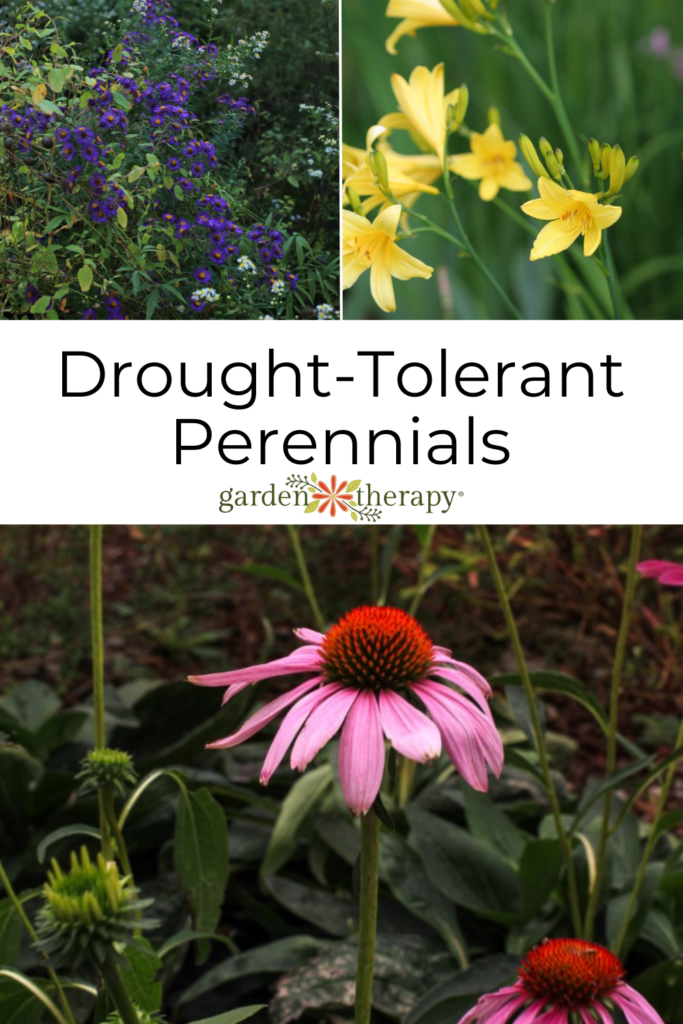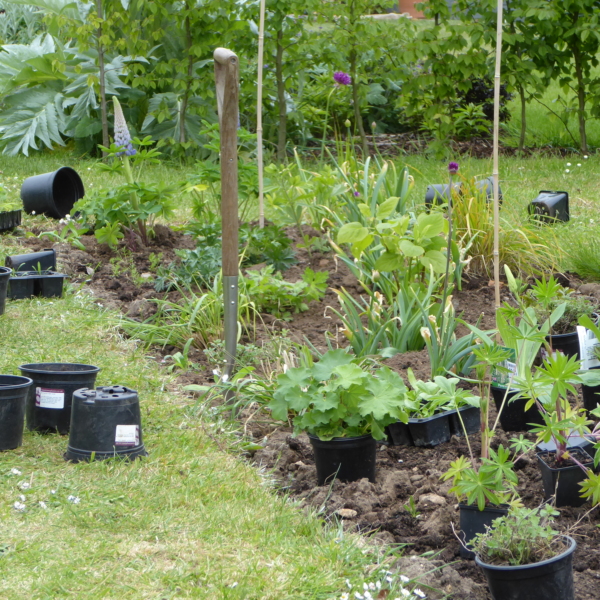Replacing your garden plants with drought-tolerant perennials is the smart choice for a low-maintenance garden that conserves water. For any hot hot summers, this can be a real lifesaver for your garden, energy, and water bill! Here are a few of my favourite drought-tolerant perennial flowers.

The climate is changing, and what we used to be able to count on for garden micro-climates is now all over the map.
By now, you may know that I live in Vancouver, BC. Vancouver is a rainforest, specifically a temperate rainforest, considered part of the rainy Pacific Northwest. It’s green and lush and mossy.
Well, it was green and lush and mossy. Now we are facing drought conditions in the summer from too little rainfall and not enough snow over winter. Drought!
The forest fires that ensue from crispy plant material are horrendous, and they spread like (I won’t say it, but you know!). All the water we have goes to fighting these fires, leaving us with watering restrictions for gardens.
As I pray for rain and water my plants with the little rainwater we have, I can’t help but think that it’s time to look into what plants can survive well and even thrive in drought conditions.
There are some cool plants here that won’t even make you think twice about those water-sucking perennials you used to have!
This post will cover…
Top 21 Drought Tolerant Perennials
Aster
Symphyotrichum spp.
Zones 3-8
Many of the other drought-tolerant perennial flowers on this list will bloom in the summer, but the aster is a late-season flower that blooms from August to October. So if you live in an area with a hot autumn, you can still enjoy some colour.
My favourite is the New England Aster (Symphyotrichum novae-angliae). It can come in pink, purple, or white. Asters need a decent amount of room, spreading 1-4 ft. wide. Every few years, they need to be divided so the center doesn’t become bare.
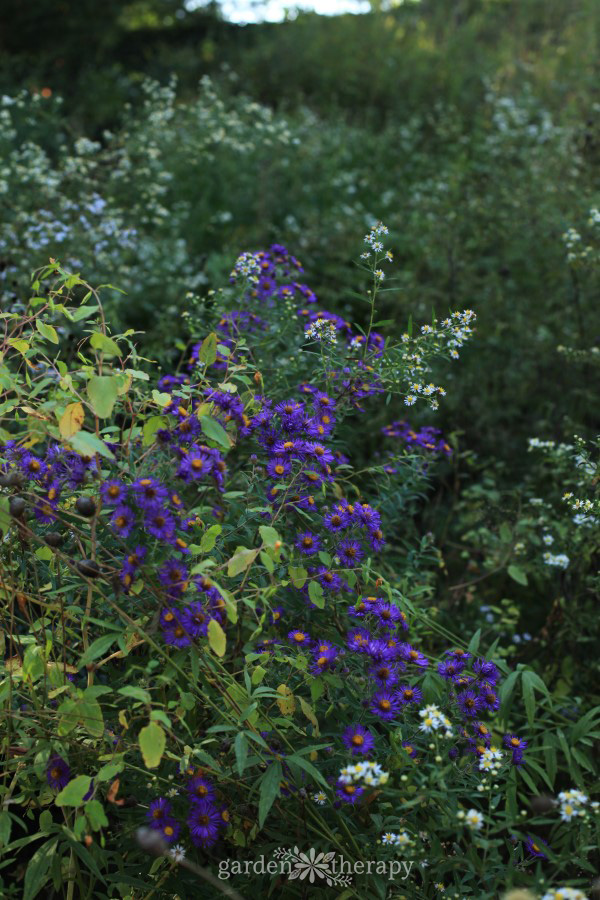
Blue Fescue Grass
Festuca glauca
Zones 4-8
To add some different texture to your garden, I highly recommend grasses. Many of them are quite drought-tolerant. Blue fescue grass is a popular option thanks to its bright blue-grey foliage.
You can use fescue frass to conserve soil moisture for neighbouring plants and prevent weed growth. It loves full sunlight, and when it’s quite hot, the plant will stop growing until it rains. Mature plants, however, are especially drought-tolerant and won’t miss a beat.
Coneflower
Echinacea purpurea
Zones 3-8
Purple echinacea is one of my favourite drought-tolerant perennial flowers. Every garden I’ve had features them from summer to fall, as they have long bloom times. They’ll bloom even after the first frost.
In their first year, they may need some protection for colder climates. But after that, they’re among the hardiest perennials you can find out there.
While fairly maintenance-free, you’ll want to routinely deadhead them to keep them blooming all season long.
Echinacea is amazing for the cold and flu season, helping to boost your immune system. Visit this post to learn you can make a tincture using echinacea root, leaves, and flowers.
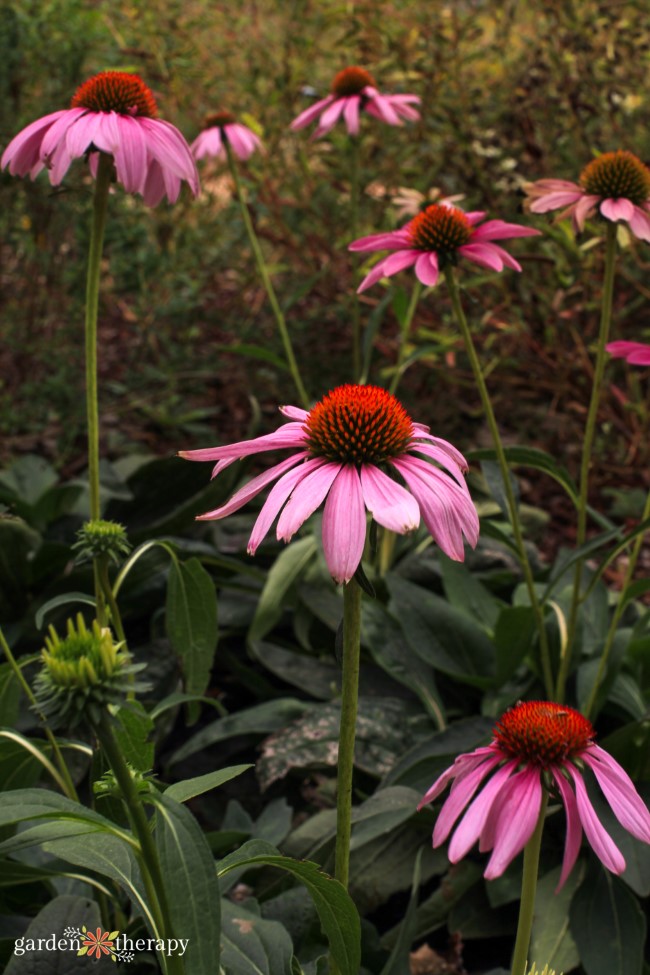
Daylilies
Hemerocallis spp.
Zones 3-10
You’ll find daylilies in many front yards and ornamental beds. They’re an excellent space filler that works well for edges. The most famous type of daylily is probably the yellow Stella d’Oro, but many more come in reds, oranges, and even purples and pinks.
Daylilies bloom from spring through to late summer. The best way to source one is by inheriting a daylily clump from another gardener. Daylilies respond well to being divided and often need splitting every few years.
Daylilies are also on my list of edible flowers.
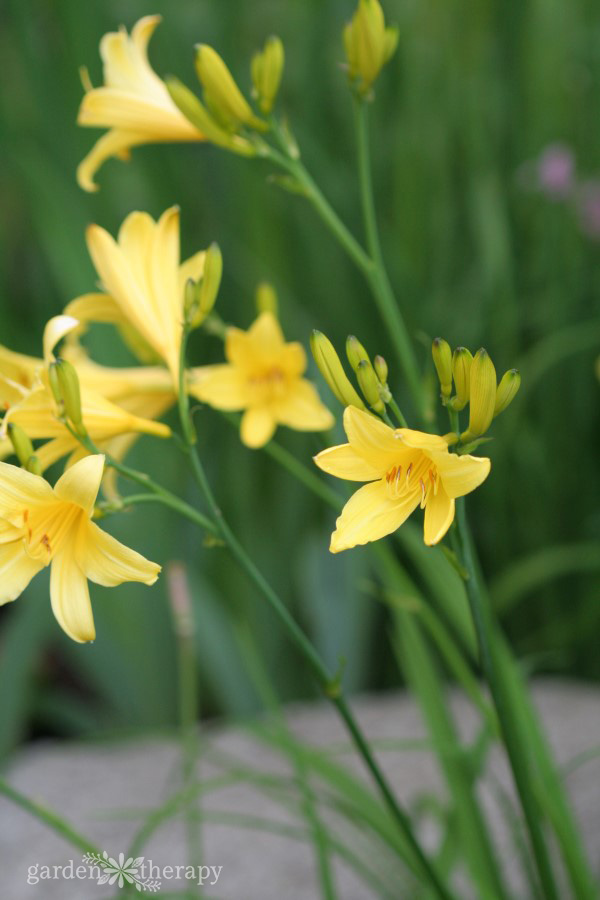
False Indigo
Baptisia australis
Zones 3-9
False indigo is a member of the pea family, Fabaceae, and creates tall, beautiful spikes of pea-like flowers. The flowers bloom from April to June atop grey-green leaves.
After the blooms fade, they’re replaced by black seed pods. They add some nice garden interest during winter if you leave them on the plant.
If you plant false indigo from seed, you’ll have to wait 3-4 years before the plant reaches its maximum height. If you’re not feeling patient, then you can plant one from the garden centre, and it should be full-sized within a year.
Feverfew
Tanacetum parthenium
Zones 5-9
Not only is feverfew a great drought-tolerant perennial, but it’s also a powerful medicinal herb. It’s well known for helping to prevent migraines and headaches and has anti-inflammatory properties.
I don’t have to worry about planting feverfew because it’s wild and will pop up without any input from me. But if you want to grow it in your garden, it’s easy to grab some seeds and then let the plant take over from there.
Feverfew self-seeds, so if you want to control the spread, make sure to deadhead and only leave a few heads to self-seed and return the following year.
Firecracker Penstemon
Penstemon eatonii
Zones 3-8
Firecracker red is right with this drought-tolerant perennial! On one of the 2-3 ft tall stems, firecracker penstemon can form 5-10 tubular, bright red flowers. It can bloom from late spring to late summer.
It grows well in dry, rocky areas and only requires partial shade, making it a very low-maintenance plant. It looks great in prairie plantings, rock gardens, and cottage gardens.
French Mallow
Malva sylvestris
Zones 4-8
Every cottage garden needs French mallow as one of its drought-tolerant perennials. It grows as a perennial in the Mediterranean and as a biennial elsewhere but will self-seed for many years of enjoyment. You may also recognize the plant by its other common name, cheeses mallow.
The flowers are a deep purple with noticeable vibrant veining. Bees love the flowers for their pollen.
French Mallow is easy to grow from seed. The plant can grow up to 5 ft high and has long, hairy stems.

Goldenrod
Solidago spp.
Zones 2-8
Native to North America, you’ve probably seen goldenrod growing amongst meadows and bush or alongside highways in ditches. While once considered a weed, many people now appreciate this wildflower’s beauty and durability.
The plant will grow fine on its own, not needing any supplemental fertilizer and very little water, except when young and not yet established. As it gets taller, it may need staking or support to prevent it from flopping over.
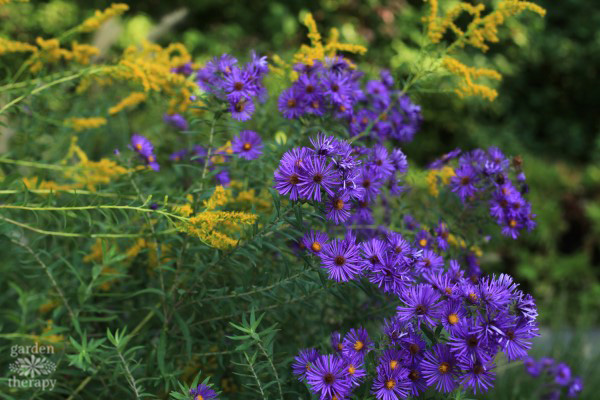
Hens and Chicks
Sempervivum tectorum
Zones 3-11
Hens and chicks get its cute name comes from the main rosette acting as the hen with the small rosettes growing from it known as the chicks. It’s one of the most popular succulents, partly because it’s so low maintenance and can survive cold winters.
As a type of succulent, it likes dry and warm climates and needs next to no supplemental watering. It can grow in sandy and rocky soil, doing well in rock gardens and in between landscaping stone.
Lamb’s Ear
Stachys byzantine
Zones 4-9
When it comes to foliage, there’s nothing quite like lamb’s ear. It has thick, silvery foliage that feels as soft as a teddy bear. In the garden, it can become a beautiful ground cover as it spreads fast.
Place them in areas where the soil is poor, and other plants struggle. When in rich soil, it can spread fast.
It doesn’t like lots of wet soil. Add a layer of mulch to prevent the leaves from getting wet and soggy.
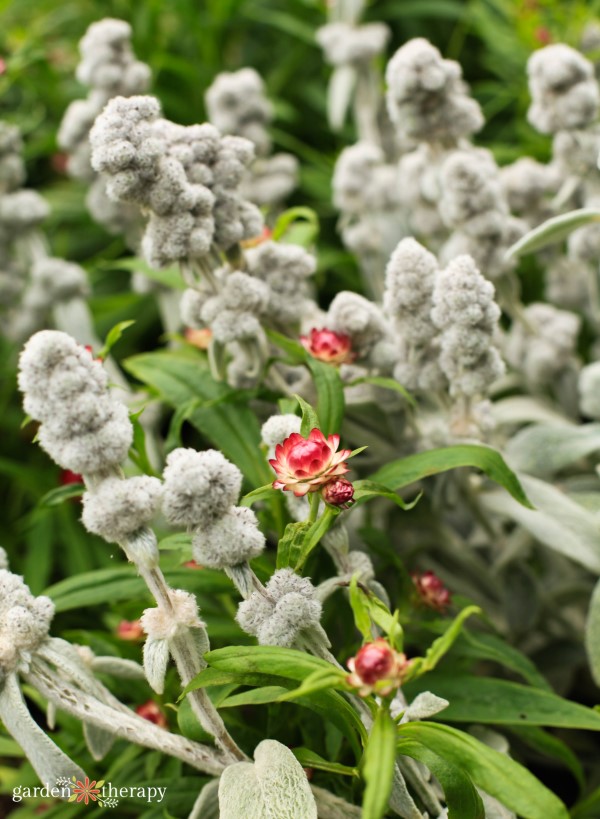
Lavender
Lavandula spp.
Zones 5-9
Lavender will always be one of my most near and dear plants. It’s one of those powerhouse plants, being beautiful, edible, medicinal, great for pollinators, and a drought-tolerant, full sun perennial.
Native to the Mediterranean, it likes hot and dry conditions in the summer and cool winters. It responds well to pruning, so shear off the spent blooms after the first round of flowers, and you may get a second round of lavender.
The two most popular types of lavender are English (Lavandula angustifolia) and Spanish (Lavandula stoechas). Both are great options for a drought-tolerant garden.
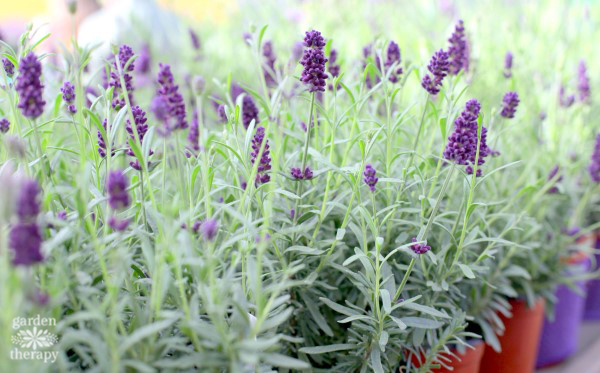
Lavender Hyssop
Agastache foeniculum
Zones 3-8
This drought-tolerant perennial is native to prairies and dry forested areas. You can find lavender hyssop in the Midwestern USA and From Ontario to BC. They’re a pollinator favourite, blooming from late summer to early fall.
Some also recognize this plant by its other name, anise hyssop, because it has a slight anise smell. It’s a member of the mint family.
Lavender hyssop can grow up to 5 ft. tall and 3 ft. wide, so they work well planted in the back of a bed. It will get lanky if planted in partial shade, so give it full sun.
Liatris
Liatris spicata
Zones 3-9
While liatris is a member of the daisy family, it doesn’t have the signature petals like others in the family. It grows in tall spikes decorated with star-like flowers that form a fuzzy-looking head. They’re a beautiful purple colour and a welcome sight for butterflies.
Most liatris is grown from corms or by purchasing starts from the garden centre. This way, they’ll flower in their first year.
Liatris are native to the prairies and are one of the best summer-flowering bulbs for cold areas. Plant the corms in early spring for purple flowers from mid-late summer.
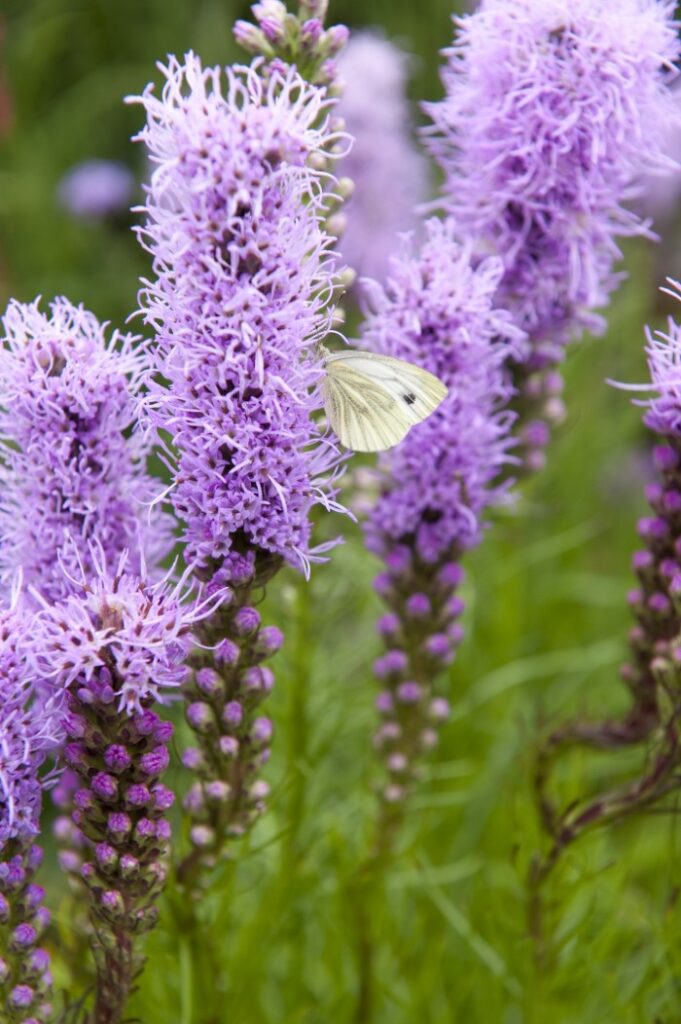
Lupine
Lupinus x hybrida
Zones 4-8
Another member of the pea family, the lupine is a beautiful wildflower that has impressive large spikes of pea-like blooms. They are most often found in purple but also come in blue, white, and yellow.
You can purchase lupine as both a perennial and an annual, so ensure you’re getting the right one! However, the plant will produce many seed pods (which are toxic).
It should be noted that some areas consider lupine an invasive species, which is toxic to humans and animals. So plant with care.

Rosemary
Salvia Rosmarinus
Zone 7-10
Rosemary is a staple for many cooks, but it’s also a beautiful ornamental shrub—that smells absolutely divine! It can grow to be 4×4 ft., so make sure you plant it somewhere with enough room.
You can grow rosemary from seed prior to the last frost, or start a plant as a cutting from someone else’s rosemary. They’re fairly inexpensive to get as a start from the garden centre as well.
There are many different rosemary cultivars; some are more cold-hardy than others. Look for one that is best suited to your area.
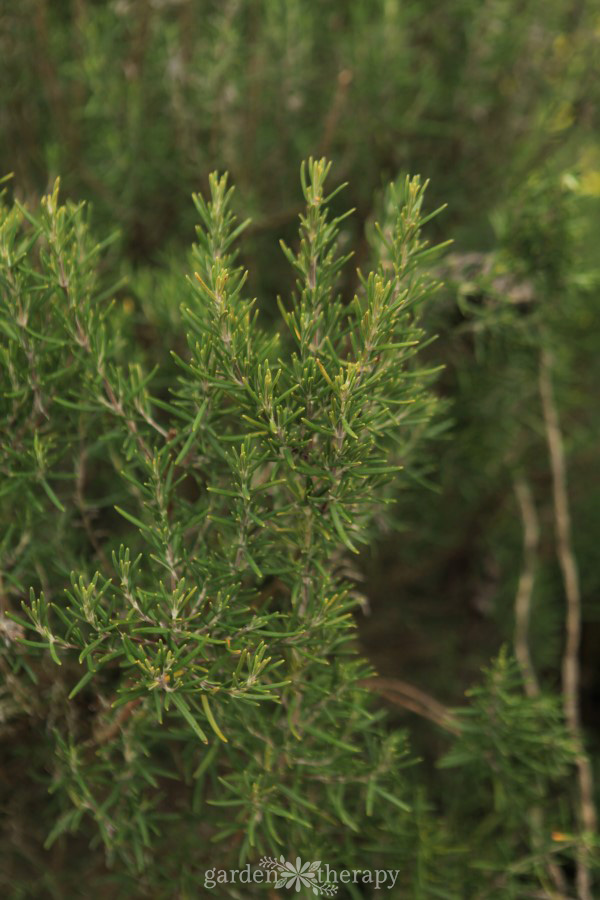
Rudbeckia
Rudbeckia hirta
Zones 3-9
You may recognize rudbeckia by its more common name, black-eyed Susan. It’s easy to see where it gets its name, with its great brown center contrasting against the yellow, daisy-like petals. Rudbeckia has turned into a garden staple, thanks to their bright appearance and low-maintenance needs.
Rudbeckia is a short-lived perennial, meaning it will live about 3-5 years before declining. The plant will self-seed, however, which can mean plenty of natural blooms.
Help your rudbeckia get established with supplemental watering in their first year. After that, they’re pretty hardy to drought conditions.
Sedum
Sedum spp.
Zones 3-10
Sedum is a beautiful groundcover succulent that is naturally drought tolerant. They have thick, fleshy leaves and produce clusters of small flowers. The leaves come in various shades, as well as the flowers.
Almost every continent has sedum, meaning you can likely find a native species to add to your full sun garden. They work well in mass plantings, in containers, groundcover, and for borders.
Sedum are self-reliant as long as they’re planted in well-draining soil and get full sun. You don’t need to worry about deadheading the spent flowers.

Thyme
Thymus vulgaris
Zones 4-11
Thyme is the general name for 300-400 species, but it’s a beloved herb for its culinary and medicinal uses. It’s native to Europe and Asia, so it can grow in various temperate climates.
Starting thyme from seed is difficult and time-consuming, so I suggest buying thyme as a start or taking cuttings from a friend.
You’ll only need to water established thyme plants when the soil is completely dry, though it can go through periods of drought just fine. Divide the plants every 3-4 years to prevent the stems from getting too woody and tasteless.
Tickseed
Coreopsis spp.
Zones 2-11
If you want to fill a bed with bright sunshine-like flowers, tickseed is the perfect plant for you! This drought-tolerant, full sun perennial is native to North America and is super low maintenance.
There are quite a few varieties of tickseed. Some will get tall and spread quite a bit, so plan accordingly.
They’re fairly maintenance-free, but if you want to encourage more blooms, deadheading is recommended. Plant them in full sun. They aren’t too particular about their soil needs.

Yarrow
Achillea millefolium
Zones 3-9
Wild yarrow is traditionally white and used for medicinal purposes, but you can find yarrow in just about any colour from the garden centre. They respond well to division, so if you have a plant with lots of stalks, try separating them before planting them for even more plants.
You can also grow yarrow from seed easily. Start them indoors before the last frost, or direct sow them outside afterwards. They’re not picky about where to grow, often sprouting from poor soil. In fact, they can be aggressive spreaders, so keep that in mind if you don’t want the wild look.

Frequently Asked Questions about Drought-Tolerant Perennials
If you’re looking to conserve water and want a drought-tolerant plant, look for native plants to your area as well as perennials. Perennials have more extensive root systems and are more established, reaching water further down in the soil than annuals. Native plants are used to the conditions in your area, growing in the wild without any supplemental watering.
Look for any plants that are native to hot, dry climates. Succulents are often a great choice for surviving on very little water in full sun climates. Mediterranean plants, as well as prairie plants, are also used to dry, hot conditions.
More Perennials to Grow

